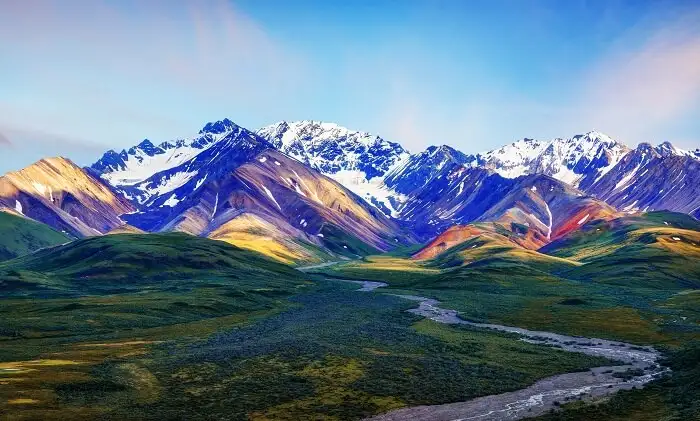Denali National Park, a majestic wilderness located in the heart of Alaska, is a destination that promises awe-inspiring landscapes and unforgettable adventures. Whether you’re an avid hiker, a wildlife enthusiast, or simply someone who loves the great outdoors, Denali has something to offer. One of the most popular activities is taking flightseeing tours, which provide a bird’s-eye view of the park’s stunning terrain, including the towering Denali peak. Flightseeing Denali is an experience like no other, giving you a unique perspective of this natural wonder. But to truly make the most of your visit, it’s essential to know the best time to visit Denali National Park.
Spring (April to May)
Springtime in Denali National Park is a season of transformation. As the snow begins to melt, the park awakens with new life. Early spring (April) can still be quite chilly, with lingering snow making some areas inaccessible. However, by May, temperatures start to rise, and the park’s flora and fauna begin to emerge from their winter slumber.
This season is ideal for those who prefer fewer crowds and a quieter experience. The wildlife is particularly active during this time, with animals such as bears, moose, and caribou becoming more visible as they forage for food after the long winter. Birdwatchers will also delight in the arrival of migratory birds.
However, it’s important to note that many of the park’s facilities and services, including some flightseeing tours, may not be fully operational until late May. If you’re planning a visit in the spring, be sure to check ahead and make necessary arrangements.
Summer (June to August)
Summer is undoubtedly the most popular time to visit Denali National Park, and for good reason. The weather is at its warmest, with temperatures ranging from 60°F to 70°F, making it perfect for outdoor activities. The park is fully open, offering a plethora of opportunities for exploration.
This is the peak season for flightseeing Denali, with numerous operators offering daily tours. These tours provide breathtaking views of the park’s rugged landscape, including glaciers, rivers, and, of course, the Denali peak itself. The long daylight hours, thanks to the phenomenon known as the Midnight Sun, mean you have more time to explore and enjoy the park.
Hiking is particularly popular in the summer, with trails ranging from easy walks to challenging backcountry routes. The park’s bus system, which provides access to deeper parts of the park, is also fully operational. Wildlife is abundant, and you’re likely to see a variety of animals, including grizzly bears, wolves, and Dall sheep.
However, summer also means larger crowds. It’s essential to book accommodations and tours well in advance to secure your spot. Despite the higher number of visitors, the vastness of the park means you can still find solitude and tranquility if you venture off the beaten path.
Fall (September)
Fall in Denali National Park is a short but spectacular season. The park is painted with vibrant autumn colors, creating a picturesque backdrop for your visit. Temperatures begin to drop, especially in the evenings, but daytime weather can still be quite pleasant.
September is a fantastic time for photography, as the fall foliage and the first hints of snow on the mountains create stunning contrasts. Wildlife sightings remain frequent, with animals preparing for the winter ahead.
Flightseeing tours are still available, offering a unique perspective of the park’s fall colors from above. The park starts to quiet down, with fewer visitors compared to the summer months. This makes it an excellent time for those looking to avoid the crowds while still enjoying the amenities and services available in the park.
One thing to keep in mind is that the weather can be unpredictable in the fall. Snow can arrive early, and some facilities may begin to close towards the end of September. It’s wise to plan for varying weather conditions and to check the status of park services before your trip.
Winter (October to March)
Winter transforms Denali National Park into a serene, snowy wonderland. While the park is less accessible during this time, it offers a unique and peaceful experience for those willing to brave the cold. Temperatures can plummet well below freezing, and snowfall is heavy.
This season is perfect for those interested in winter sports such as cross-country skiing, snowshoeing, and dog sledding. The Northern Lights, or Aurora Borealis, are also a major draw during the winter months, providing a magical display in the night sky.
Flightseeing tours are limited in winter due to the extreme weather conditions, but some operators still offer tours, weather permitting. These tours can provide stunning views of the snow-covered landscape and are a truly memorable experience.
Winter is the least crowded season, offering solitude and a sense of wilderness that is hard to find during the busier months. However, it requires careful planning and preparation, as many of the park’s services are closed, and the weather can be harsh.
Conclusion
The best time to visit Denali National Park ultimately depends on what you hope to experience. Each season offers its own unique charms and challenges. Whether you choose to witness the park’s awakening in spring, the vibrant life of summer, the breathtaking colors of fall, or the tranquil beauty of winter, Denali promises an unforgettable adventure. And no matter when you visit, don’t miss the chance to take a flightseeing tour—it’s the best way to truly appreciate the grandeur of this Alaskan gem.
